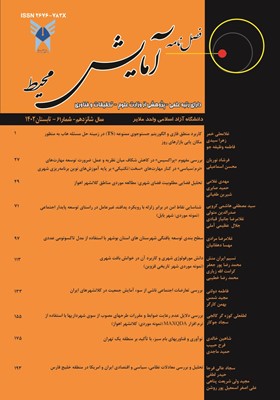بررسی تعارضات اجتماعی ناشی از سوء آمایش جمعیت در کلانشهرهای ایران
محورهای موضوعی : آمایش محیطفاطمه دولتی 1 , مجید شمس 2 * , بهمن کارگر 3
1 - دانشجوی دکتری تخصصی رشته جغرافیا و برنامه ریزی، واحد علوم و تحقیقات، دانشگاه آزاد اسلامی، تهران، ایران
2 - استاد تمام و عضو هیئت علمی واحد ملایر , دانشگاه آزاد اسلامی، ملایر، ایران
3 - (استادیار دانشگاه علوم انتظامی، تهران، ایران)
کلید واژه: جمعیت, آمایش, تعارضات اجتماعی, کلانشهرهای ایران,
چکیده مقاله :
جمعیت و ابعاد گوناگون آن همواره ذهن سیاستگذاران و صاحبنظران را به خود معطوف داشته است. رشد طبیعی جمعیت حاصل میزان موالید و مرگ ومیر است. مهاجرت و جابجایی تأثیر بسزایی در افزایش یا کاهش تحولات آمایشی جمعیت خواهد داشت. حاشیه نشینی و ایجاد سکونتگاههای غیررسمی، افزایش نرخ زمین و مسکن، تخریب محیط زیست، مصرف بیرویه آبهای زیرزمینی، کاهش سرانه فضای سبز، ترافیک و آلودگی هوا، تولید پسماند شهری و دفع نامناسب آن، فرسایش خاک، آلودگیهای صنعتی همه از جمله معضلات، چالشها و تعارضات بهوجود آمده ناشی از افزایش و تمرکز جمعیت درکلانشهرهای کشور میباشند. بر مبنای روش، این تحقیق از نوع آماری کتابخانهای(توصیفی – تحلیلی) میباشد. مطابق با چارچوب نظری تحقیق، تمامی مؤلفهها در دو سطح جهانی و کشوری با محوریت ایران بررسی و اطلاعات مورد نیاز گردآوری و نقاط قوت و ضعف پژوهش شناسایی شد. جهت غربالگری واولویتبندی از مدل رتبه و اندازه و الگوریتم منحنی لورنز استفاده گردید. ابتدا اطلاعات جمعآوری شده از طریق نرمافزار اکسل تحلیل و سپس توسط منحنی لورنز تبدیل به نمودار عددی گردید. یافتههای تحقیق نشان میدهد که همزمان با رشد و تمرکز جمعیت درکلانشهرها، توسعه و پیشرفت به موازات آن شکل نگرفته و در بین طبقات و سطوح مختلف جامعه اختلافات و تعارضاتی ایجادگردیده که ناشی از ازدحام و تحرکات جمعیت و عقب ماندگی توسعه در شهرها و کلانشهرها میباشد.
Population and its various dimensions have always been a concern for policymakers and experts. Natural population growth is the result of birth and death rates, while migration and mobility have a significant impact on the increase or decrease of demographic changes. Marginalization and the establishment of informal settlements, increasing land and housing prices, environmental degradation, indiscriminate use of groundwater, reduction of per capita green space, traffic and air pollution, urban waste generation and improper disposal, soil erosion, and industrial pollution are among the challenges and conflicts that arise from population growth and concentration in the country's metropolises. Based on the research methodology, this study follows a descriptive-analytical approach. According to the theoretical framework, all components were examined at the global and national levels with a focus on Iran, and the necessary information was collected to identify the strengths and weaknesses of the research. The ranking and prioritization model and Lorenz curve algorithm were used for screening and prioritization. First, the collected data were analyzed using Excel software and then transformed into numerical charts using the Lorenz curve. The research findings indicate that simultaneous with population growth and concentration in metropolises, development and progress have not occurred in parallel, and various differences and conflicts have emerged among different social classes and levels due to overcrowding, population movements, and development disparities in cities and metropolises.
_||_

